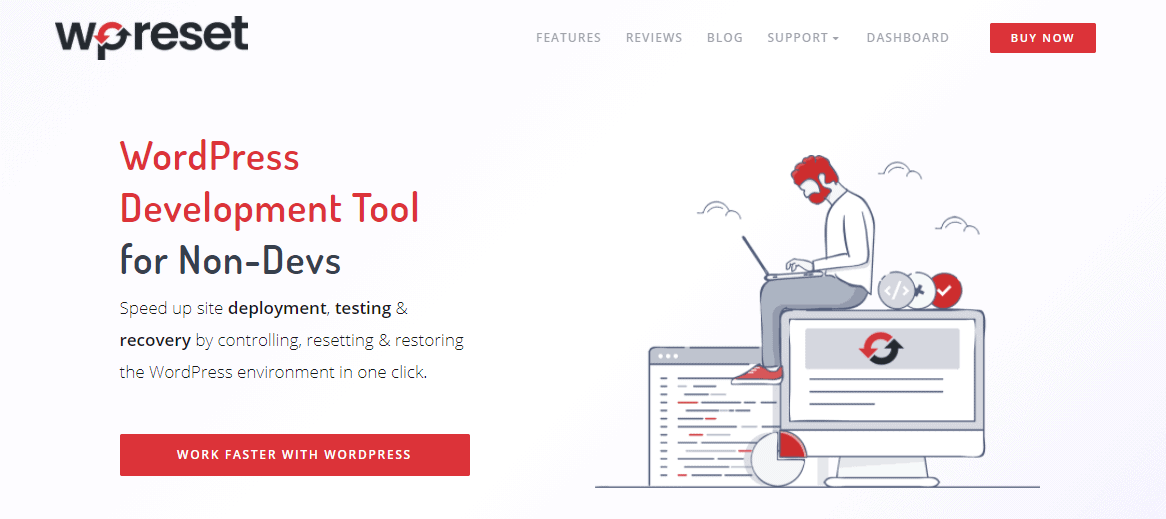How to Fix Your WordPress Site With the Free Emergency Recovery Script: The Best Solution for the Most Annoying Issues
If you’re anything like the average backend operator, you’ve most likely been in a situation where your site is down, and there seems to be no way out. Whether you’re locked out of the site or encountered the dreaded white screen of death, those will be the times when you’re scrambling to regain your footing and make your site operational again.
Most of the go-to actions that will first come to mind will be centered around manually checking all the folders and files you can get ahold of. But what if there’s a much quicker and ultimately safer method? We’ve been working with and testing out the Emergency Recovery Script, and it blew us away, so we decided to share our thoughts with you.
What is Emergency Recovery Script?
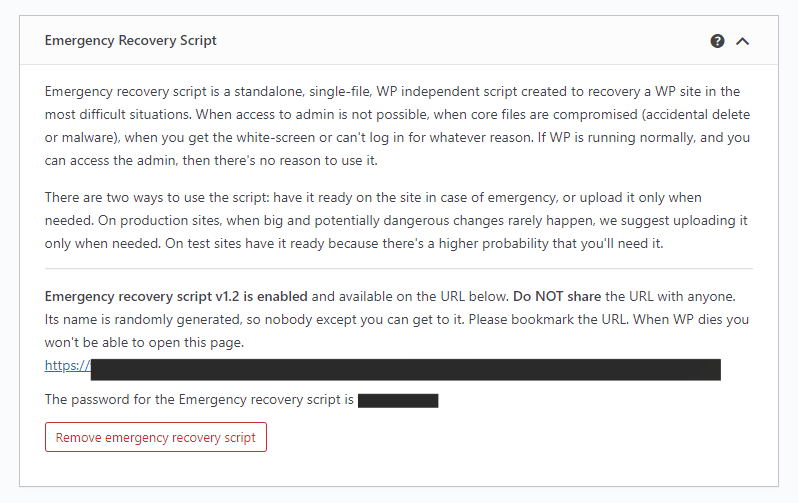
To put it in technical terms, it’s a standalone, single-file PHP script that’s independent of WordPress and aims to recover your site in case of failure. In layman’s terms, it’s your “get out of jail free” card you use when you hit the wall and don’t know what else to do.
The fact that, when using this tool, you don’t even have to access the WordPress dashboard means it’s immune to practically any type of problem you may encounter. Additionally, everything is automated, and the user interface is simplified so that anyone can use it, from beginners to pros, regardless of their coding knowledge.
If you prefer watching videos instead of reading, you can learn more about ERS in the video below (it is covered after the first 18 seconds).
In What Situations Do You Use Emergency Recovery Script?
On Test/Staging Sites
If you’ve ever run tests, you know that going through every option that’s available to you to see what works and what doesn’t on a test or staging site can get ugly rather quickly. The work you do here is, in fact, a test of endurance, where you just must tough it out. ERS helps immensely because there are times where you just get stuck and simply can’t backtrack to a working state from the dashboard, so having a tool that can revert things without having to access the dashboard at all is invaluable.
Can’t Access a Site
There might come a situation where your site is live, i.e., you and your visitors can access it from the frontend, but you can’t access it as the admin from the backend. Naturally, if you can’t get to your site, you can’t figure out what went wrong. ERS will enable you to delete all current users (which is advised since that may be what’s corrupted) and create new ones. Within a few moments, you’ll be able to access everything you need.
Plugin/Theme Breaks the Site

Problems with compatibility don’t stop once the site goes live. Since WordPress offers so many plugins and extensions, it’s expected that some of them won’t mesh well with others. When a conflict occurs, it can have ramifications like your site’s display getting all messed up, pages going missing, links and/or frontend widgets not working, etc. ERS can turn the situation around, making your site function as it did before you added the problematic software.
Restoring Snapshots
If you’re using WP Reset (more on that later) with ERS, you’ll be able to restore your site using many of the automatically or manually created snapshots. If you’re unfamiliar with the method, think of snapshots as restore points in Windows – site states in which everything works fine, and you can revert to if something went wrong in the meantime.
White Screen of Death (Error 500)
The dreaded white screen of death pales in comparison to the might of ERS. Usually, when you encounter it, you’d have to go through hours and hours of arduous coding to even get access to your site, and that method is only available to those who know what they’re doing; others will most likely be forced to reset a site which could mean loss of data (depending on your backup situation). ERS handles the issue in a couple of minutes, giving you options to connect remotely, restore all core files, delete any that shouldn’t be there, and set up new user accounts.
Tools That Come With Emergency Recovery Script
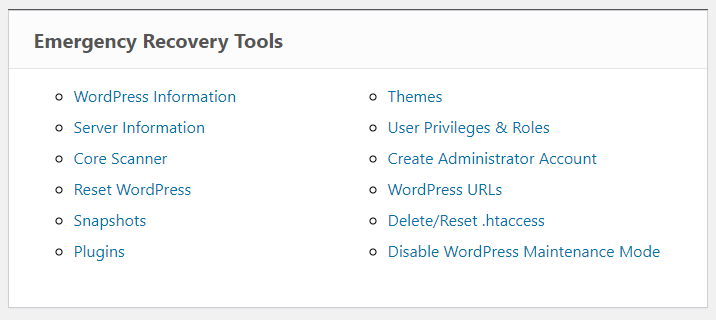
WordPress Information
This is very much like your overview page – ERS compiles various data about your WordPress installation, such as the WP version or the location of wp-config.php, among other things. The provided data will also give you confirmation if ERS is properly connected to your site. For example, if the WordPress version provided doesn’t match the one that’s actually on your site, there could be issues you need to go through.
Server Information
Much like the general WordPress information just mentioned, server information will provide you with data about the server like its PHP and MySQL versions and access to the phpinfo() function. Knowing these kinds of details enables you to limit issues caused by conflicting/incompatible software you’d potentially incorporate into your site.
Core Files
As their name suggests, core files are what makes a WordPress site tick. Being so essential, it’s absolutely crucial that these files are always kept in pristine condition. That means no additions, overwriting, deleting, moving, cutting, pasting, or anything else. What ERS does is compare your current core files’ state to a master copy on wordpress.org.
The first thing you get is a report that shows if anything’s amiss. Of course, if everything is fine, you stop there, but if anything is wrong, you’ll need to take action. Modified files can be instantly replaced by original ones that are automatically downloaded. The same goes for missing files which can be added in the same manner.
If there’s a surplus of files (malicious or not), these will be flagged, and you’ll get to remove them with a simple click. Note that plugin and theme files aren’t considered as core, so if there are any issues with them, scanning the core files won’t yield results.
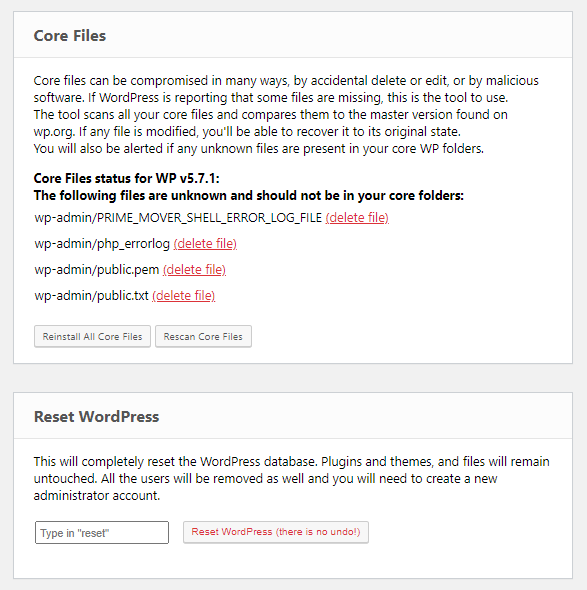
Reset WordPress
Resetting WordPress will probably be your last-ditch effort to start from a clean slate after things have gone too far. Although it is a big deal, resetting a site doesn’t mean you’ll lose everything – no files are deleted at all, so you’ll keep your uploads, themes, plugins, etc. What is gone is the entire database, along with all user accounts – you’ll have to create, at least, a new admin user with the Administrator Account tool.
If you want more options for resetting your site, try out the plugin ERS accompanies – WP Reset PRO. It offers much more variety.
Snapshots
Speaking of WP Reset, if you are using it in tandem with ERS, you’ll get to restore your site to a state saved in any of the snapshots created within the plugin. Additionally, if you’ve stored snapshots remotely, you’ll have the option to upload them and subsequently use them. Snapshots have proven to be invaluable with testing sites where you can quickly revert the site state after you’ve made any changes.
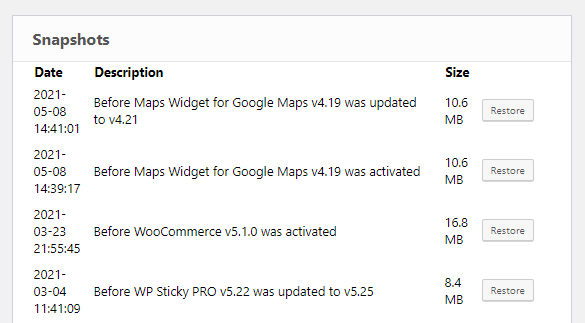
Plugins
As we’ve mentioned, the WordPress repository is home to a seemingly endless supply of plugins, and it’s to be expected that some of them don’t work well together or at all. Before ERS, you would have to scour your WordPress installation directory to manually find the right files to delete them. With ERS, however, all you need to do is click on the “Disable” button, and the work is done. The interface is the same as the Plugins tab on your dashboard – you get a list of all installed plugins and a chance to manage them.
Themes
Just like plugins can be accessed and disabled, so can themes. The principle is the same as it is with plugins. You ditch the process of going through files manually using FTP and instead get everything done through the ERS interface.
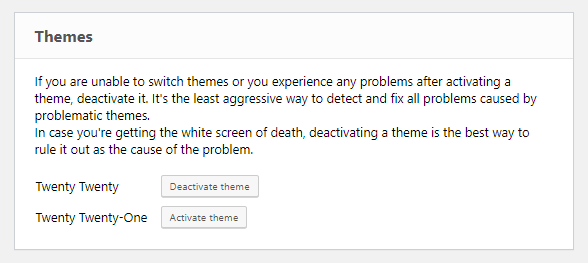
User Privileges & Roles
Often, trouble with backend WordPress management includes login issues. This can come in various ways – you can’t log in at all, you can but are classified as a guest (not admin), etc. The biggest issue that comes from this is that you simply can’t access anything you need to rectify the situation. Since ERS is a tool independent of WordPress, it’s the perfect solution to combat this. You can use it to roll back accounts and privileges to their default state, enabling all users to restore their original roles.
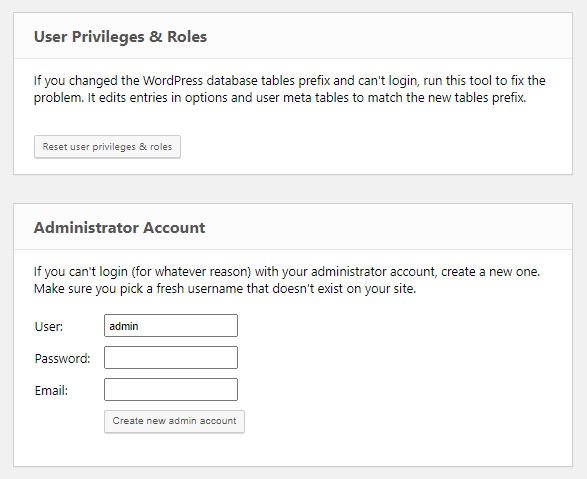
Administrator Account
If things have escalated to the point where users can’t even be rolled back to assume normal roles, there’s always the option to start anew. When all else fails, you can always fall back on the ERS function to create a new admin account. It’s as easy as creating a new account anywhere else – you just input a username, password, and email and you’re all set. To avoid potential conflicts, be sure to delete the previous accounts that aren’t working.
WordPress URLs
Sites will sometimes switch from HTTP to HTTPS, which can cause problems across the board, most commonly with logins, especially if the switch is made without a valid SSL certificate. If it ever comes to this, you’ll be able to change the URLs back to their working state and, in doing so, fix the issues your site has experienced.
Delete or Reset .htaccess
The .htaccess file is very sensitive and tricky to modify in any way; it should be avoided by anyone who doesn’t have extensive knowledge. If you’ve decided to go for it regardless, there’s a high chance you might encounter the white screen of death (error 500). With virtually no feedback about what went wrong, you’ll have to either reset it or delete the file altogether. After you’ve done this, your job isn’t done; you’ll need to log in as admin, open Permalinks within the setting menu, and click Save to regenerate them.
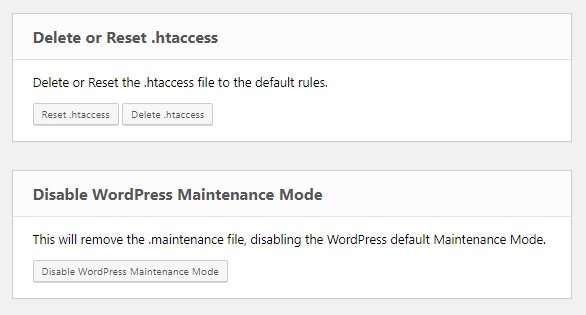
Disable WordPress Maintenance Mode
Maintenance mode is something WordPress runs by default every time you upgrade your core files, themes, or plugins. Most of the time, it won’t even register because everything went according to plan. Sometimes, however, a problem will arise, and you’ll be stuck in maintenance mode without the ability to exit. If this ever happens, you can use ERS to exit maintenance mode and resume regular actions with just one click.
How Do I Get Emergency Recovery Script?
There are two ways to get your hands on ERS. The first is the free option that, honestly, everyone should get for their site even if they don’t think they need it. You can do that on the official site.
The second way to get ERS is through WP Reset. WP Reset is a fantastic utility tool you can use in several ways; when you’re testing your site, you need to roll it back, make backups, etc. In the case of the WP Reset package, ERS is even better because of the great integration the two tools have (for example – the aforementioned restore snapshot function).
FAQ

Is Emergency Recovery Script Safe?
Yes, the unique URL you get is secret, known only to you, so there’s no chance for it to somehow get into the wrong hands. ERS can be installed as a precaution when everything is working or as a last-ditch solution when something goes wrong. Finally, nothing can be deleted/restored automatically, every action is manual, and some even require more than one confirmation to avoid potential accidents.
More info about ERS security can be found at this link!
Is Emergency Recovery Script Free?
Yes, some of its tools are free, while others require you to get WP Reset along with ERS.
How to Install Emergency Recovery Script?
The process is rather simple. You’ll need to download the ERS file that needs to be uploaded to your WP root folder using FTP or cPanel. During the process, you’ll get a unique filename and password, so everything is protected. Once done, you can access ERS through the unique URL you’re given. For more details regarding installation, be sure to check out the official site.
Summary
As we’ve mentioned, since ERS has a free version, there is no reason you shouldn’t have it as a failsafe in case things go wrong. For added security, you can combine it with WP Reset and get even more features as well as full access to everything ERS has to offer. Be sure to give it a try!
- How To Make a WhatsApp Group Interesting? - July 4, 2024
- Top 6 High-Paying Affiliate Programs in 2024 - June 14, 2024
- What is DragGAN AI Tool and how to use it? - June 7, 2024
Where Should We Send
Your WordPress Deals & Discounts?
Subscribe to Our Newsletter and Get Your First Deal Delivered Instant to Your Email Inbox.

